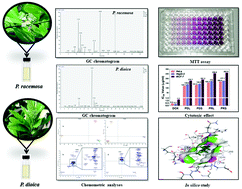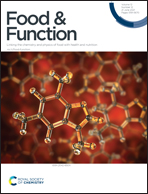Pimenta dioica and Pimenta racemosa: GC-based metabolomics for the assessment of seasonal and organ variation in their volatile components, in silico and in vitro cytotoxic activity estimation†
Abstract
Volatile constituents isolated from the stems (S) and leaves (L) of Pimenta dioica (PD) and Pimenta racemosa (PR) during the four seasons were analyzed using GLC/FID (Gas liquid chromatography – flame ionization detector) and GLC/MS (Gas liquid chromatography – mass spectrometry). Eighty-nine compounds were identified in all samples, in which oxygenated monoterpene represented by eugenol was the major constituent in PDS-S3 (autumn) (88.71%) and PDS-S2 (summer) (88.41%). Discrimination between P. dioica and P. racemosa leaves and stems in different seasons was achieved by applying chemometrics analysis comprising Principal Component Analysis (PCA) and Hierarchal Cluster Analysis (HCA). For P. dioica, they were partially segregated where leaves collected from spring and autumn were superimposed, and similarly for P. dioica stems collected in summer and autumn. For P. racemosa leaves, the PCA score plot showed that all seasons were completely segregated from each other, with the winter and autumn samples being in very close distance to each other. P. racemosa stems collected in autumn and spring exhibited significant variation, as they were completely detached from each other. Moreover, summer and winter fell in a near distance to each other. An in vitro cell viability assay was done to evaluate the variation in the cytotoxicity of the isolated essential oils against breast (MCF-7), hepatic (HepG-2), and cervical (HeLa-2) cancer cell lines using the MTT assay. The maximum cytotoxic effect was observed by PDL against HeLa, HepG-2 and MCF-7 cells with IC50 values equal to 122.1, 139.6, and 178.7 μg mL−1, respectively. An in silico study was done to assess the cytotoxic effect of the major compounds detected in the oils by determining their inhibitory effect on human DNA topoisomerase II (TOP-2), human cyclin-dependent kinase 2 (CDK-2) and matrix metalloproteinase 13 (MMP-13). o-Cymene followed by eugenol showed the highest fitting with all of the examined proteins approaching doxorubicin. It can be concluded that GC coupled with chemometrics provide a strong tool for the discrimination of samples, while Pimenta could afford a natural drug that could alleviate cancer.



 Please wait while we load your content...
Please wait while we load your content...